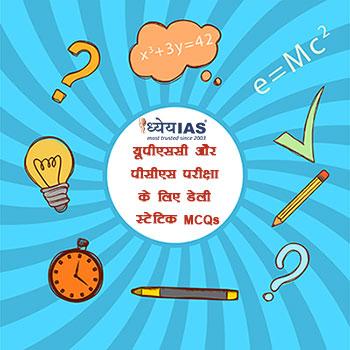Daily Static MCQs Quiz for UPSC, IAS, UPPSC/UPPCS, MPPSC. BPSC, RPSC & All State PSC Exams
Subject : Science and Technology
1. Consider the following statements regarding Superconductivity:
1. Superconductivity is a state in which a material shows very high electrical resistance.
2. Superconducting materials can save huge amounts of energy, and be used to make highly efficient electrical appliances.
3. Superconductivity is possible only at high temperatures.
How many of the above statements is/are correct?
(a) Only one
(b) Only two
(c) All three
(d) None
Answer: (A)
Explanation: Superconductivity is a phenomenon that, so far, has been possible only at extremely low temperatures, in the range of 100°C below zero. The search for a material that exhibits superconductivity at room temperature, or at least manageable low temperatures, has been going on for decades. Superconductivity is a state in which a material shows absolutely zero electrical resistance. While resistance is a property that restricts the flow of electricity, superconductivity allows unhindered flow. Because of zero resistance, superconducting materials can save huge amounts of energy, and be used to make highly efficient electrical appliances. Hence, only statement 2 is correct.
2. A planetary-mass object is recognised as Dwarf planets if it satisfies which of the following conditions?
1. It must be in direct orbit of the sun.
2. It must have cleared the neighborhood around its orbit.
3. It must be massive enough for it to have become spherical in shape under its own gravity.
Select the correct answer using the code given below:
(a) 1 only
(b) 1 and 2 only
(c) 1 and 3 only
(d) 1, 2 and 3
Answer: (C)
Explanation: According to the definition adopted by the International Astronomical Union (IAU) in 2006, a dwarf planet is, “a celestial body orbiting a star that is massive enough to be rounded by its own gravity but has not cleared its neighboring region of planetesimals and is not a satellite. In essence, the term is meant to designate any planetary-mass object that is neither a planet nor a natural satellite that fits two basic criteria. For one, it must be in direct orbit of the sun and not be a moon around another body. Second, it must be massive enough for it to have become spherical in shape under its own gravity. And, unlike a planet, it must have not cleared the neighborhood around its orbit. Hence, statement 2 is not correct.
3. Consider the following statements regarding Zoonotic diseases:
(a) Zoonotic diseases are mainly infectious diseases that are naturally transmitted between vertebrate animals and humans.
(b) Brucellosis is a zoonotic infection caused by the bacteria of the genus Brucella.
(c) Zoonotic pathogens may be bacterial, viral or parasitic, or may involve unconventional agents.
How many of the above statements is/are correct?
(a) Only one
(b) Only two
(c) All three
(d) None
Answer: (A)
Explanation: A zoonosis is an infectious disease that has jumped from a non-human animal to humans. Zoonotic pathogens may be bacterial, viral or parasitic, or may involve unconventional agents and can spread to humans through direct contact or through food, water or the environment. Various studies indicate that more than two-thirds of existing and emerging infectious diseases are zoonotic. The transboundary impact of viral outbreaks in recent years such as the Nipah virus, Ebola, Severe Acute Respiratory Syndrome (SARS), Middle East Respiratory Syndrome (MERS) and Avian Influenza. Brucellosis is a zoonotic infection caused by the bacteria of the genus Brucella. Hence, all statements are correct.
4. Consider the following statements regarding Stem cells:
1. Stem cells are unspecialized cells capable of renewing themselves through cell division.
2. In many tissues they serve as a sort of internal repair system.
3. When a stem cell divides, each new cell will always be a stem cell.
How many of the above statements is/are correct?
(a) Only one
(b) Only two
(c) All three
(d) None
Answer: (B)
Explanation: Stem cells have the remarkable potential to develop into many different cell types in the body during early life and growth. In addition, in many tissues they serve as a sort of internal repair system, dividing essentially without limit to replenish other cells as long as the person or animal is still alive. When a stem cell divides, each new cell has the potential either to remain a stem cell or become another type of cell with a more specialized function, such as a muscle cell, a red blood cell, or a brain cell. Stem cells are distinguished from other cell types by two important characteristics:
- First, they are unspecialized cells capable of renewing themselves through cell division, sometimes after long periods of inactivity.
- Second, under certain physiologic or experimental conditions, they can be induced to become tissue- or organ-specific cells with special functions.
In some organs, such as the gut and bone marrow, stem cells regularly divide to repair and replace worn out or damaged tissues.
Hence, statement 3 is not correct.
5. Consider the following statements:
1. The process of copying genetic information from one strand of the DNA into RNA is termed as transcription.
2. Bacteria contain only mRNA (messenger RNA) and do not have any tRNA (transfer RNA).
Which of the above statements is/are correct?
(a) 1 only
(b) 2 only
(c) Both 1 and 2
(d) Neither 1 nor 2
Answer: (A)
Explanation: The process of copying genetic information from one strand of the DNA into RNA is termed as transcription. In bacteria, there are three major types of RNAs: mRNA (messenger RNA), tRNA (transfer RNA), and rRNA (ribosomal RNA). All three RNAs are needed to synthesise a protein in a cell. The mRNA provides the template, tRNA brings aminoacids and reads the genetic code, and rRNAs play structural and catalytic role during translation. There is single DNA-dependent RNA polymerase that catalyses transcription of all types of RNA in bacteria. RNA polymerase binds to promoter and initiates transcription (Initiation). Hence, statement 2 is not correct.








